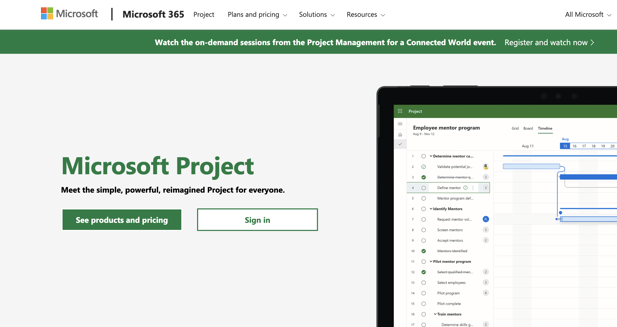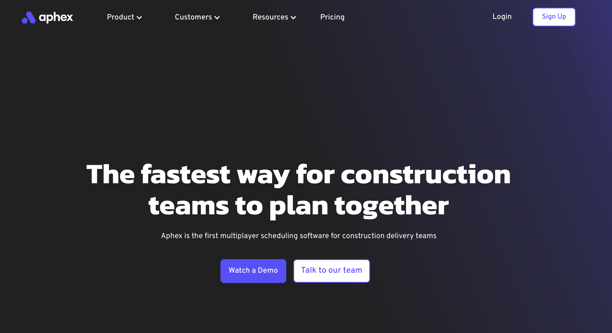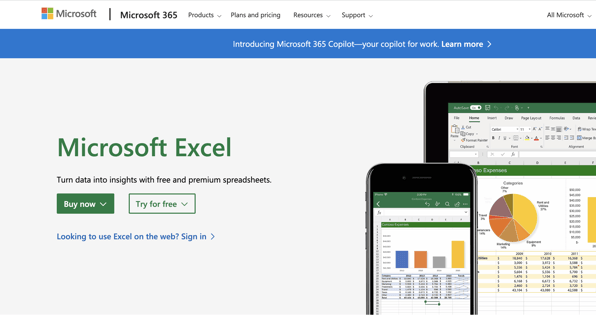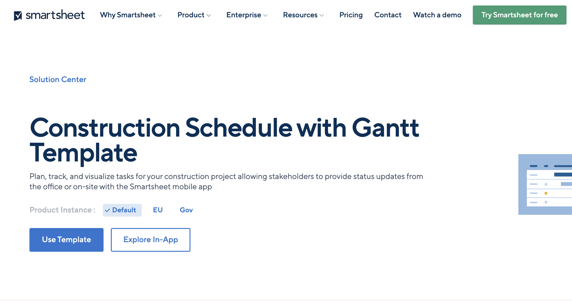- Microsoft Project
- Aphex
- Excel
- Smartsheet
Things to consider when choosing Gantt chart software for your project
When choosing any new software for your project, the most important thing to consider is how well it solves your problem and whether or not your team will actually want to use it. But to make choosing Gantt software easier, ask yourself the following questions.
Is it easy to use?
Good Gantt software should make it easy to quickly create and edit tasks, assign resources, and track progress. It should also allow you to customise your chart to fit your project’s needs.
Does it help improve communication?
All projects require good communication. So it’s important to consider software with features that allow real-time updates, advise ownership, or promote interfacing etc.
Does it integrate with your other tools?
Consider whether or not your chosen Gantt software can be easily integrated with the other project management tools you use. E.g Can you import plans from your Master Schedule?
How much does it cost?
Most projects find that getting a budget for software can be quite challenging. So it’s important to know whether the Gantt software you’re looking at is either within your current budget or will have a large enough impact on the project to warren a higher budget.
Is this suitable for my project?
There are many options when it comes to Gantt chart software. Understanding the benefits and limitations of each will help you decide whether your chosen tool is a suitable fit for your project.
By keeping these things in mind, you’ll be sure to find a Gantt chart software that makes your life (and your team’s) much easier.
Popular Construction Gantt Chart Software
Below, you’ll find four of the most popular Gantt chart tools used by planning and construction delivery teams. Each has its merits and, depending on your project needs and budget, could be the right option for you and your team.
Microsoft Project

Recommended for: High-level planning and master scheduling on small to medium projects.
Chances are, you’ll already be very familiar with Microsoft Project. It’s been widely used in construction for some time now, and you’ve probably seen or worked from plans and schedules that have been produced using it.
It’s a robust and comprehensive project management software that can help you create detailed Gantt charts to plan your entire project.
That being said, Microsoft Project has quite a steep learning curve, and while the software is user-friendly, it can take some time to get used to its features and capabilities. And it’s more suited to planning that’s been carried out by a select few, rather than a wider team of engineers.
Because it has such a broad array of possible functions, it tends to be a popular choice for planning teams working on the master schedule. But it can feel clunky and cumbersome for those trying to work on more granular, dynamic plans (such as lookaheads).
Features:
Task Management
Create and manage tasks, assign resources, set durations, and add dependencies.
Gantt Chart View
Display your project schedule as a horizontal bar chart, adjust bar lengths, and track progress.
Resource Management
Assign and track resources such as materials, equipment, and personnel.
Cost Management
Create and track budgets, allocate costs to tasks, and monitor project costs.
Critical Path Analysis
Microsoft Project can automatically calculate the critical path and highlight it on the Gantt chart, helping you identify tasks critical to the project’s success.
Aphex

Recommended for: Engineers and construction delivery teams on tier-one projects.
Aphex is an easy-to-use, multi-player scheduling software that helps construction delivery teams build short-term plans quickly. You can create, edit, and update your Gantt charts with just a few clicks, and the drag-and-drop functionality allows you to rearrange tasks and adjust timelines.
When building your plans in the Gantt, you can easily manage your resources by assigning personnel, equipment, and materials to specific tasks and tracking their availability.
One of the great things about using Aphex to build your Gantt charts is that it’s designed to manage the entire short-term scheduling process. It seamlessly integrates with all your required project management tools and takes all of the frustration out of communicating with your team.
Features:
Task Dependencies
Set up task dependencies to ensure that your project stays on schedule. Aphex helps you ensure that each task is completed before the next one can begin, reducing the risk of delays and bottlenecks.
Resource allocation
Allocate resources, such as labour and equipment, to tasks in your Gantt chart.
Real-time collaboration
Have different teams access the Gantt from anywhere at any time - helping you improve communication, reduce errors, and ensure that everyone is working from the most up-to-date version of the plan.
Easy Distribution
Quickly share your plans with a web-only view of the Gantt or convert them to a PDF that can be printed and placed around the site.
Excel

Recommended for: Small project teams on a tight budget
When building Gantt charts, Excel has long reigned as the go-to solution for Engineers and delivery teams trying to build out short-term plans.
As a sibling product to Microsoft Project, it offers many of the same features (Regarding Gantt charts) but is a bit lighter and easier to use.
With Excel, you can create clear and organised visuals. And once you’ve got the structure of your Gantt in place, you can easily input your project tasks and timelines; then, use formatting options to create plans that are easy to understand.
However, there are some downsides to using Excel for Gantt charts. One of the biggest challenges is that it can be difficult to change and update your chart once it’s been created. If you need to adjust your tasks or change your timelines, you may need to start from scratch. Not ideal when you’re updating your plans on Friday evening.
Additionally, Excel is not the best tool for large teams of people that need to communicate with each other as it has limited functionality for sharing your plans and documents.
Features:
Conditional formatting
Allows you to colour-coded cells based on specific criteria.
Custom formulas
Create formulas to calculate important information, such as task durations and completion dates.
Filter and sort data
To organise your project schedule.
Notes and comments
Add additional information to cells to expand on tasks or clarify information.
Smartsheet

Recommended for: Mid-sized projects that don’t require integration with other construction management tools.
A more generic project management software that offers a range of customisable templates that can be used to build Gantt charts for your project. It’s easy to use and can quickly get set up without hassle.
Smartsheet comes with some pre-built functions that are helpful for managing small to mid-sized construction sites. However, there are clear limitations for teams working on bigger, more complex projects.
For example: Resource allocation is limited to people, you can only have one baseline per project, there is no multi-player functionality, and the import process primarily uploads dates - like Excel.
Whilst construction-focused functions are limited, Smartsheet still provides a simple and easy-to-use solution for teams that just require access to a basic Gantt.
Features:
Customisable templates
A range of templates are available from the Smartsheet website, designed to aid people using the tool for construction.
Task dependencies
To help ensure your project stays on schedule.
Cloud-based
That allows team members to access the Gantt chart from anywhere.
Progress tracking
Identify potential delays and take action to keep your project on track.
Conclusion
When choosing software for your project, the important thing is that you end up with something that will fit your project.
Choosing new project management software and getting teams trained on using it can cost you time (that you don’t have), and the last thing you want is to end up getting burnt with something that isn’t quite right for the team that’s using it.
We’ve tried to give a rough idea of who each of the mentioned tools is best suited to, but the best way to know for sure is to have someone that’s going to be managing your Gantts trial the tool before you commit.
If you think Aphex might suit your project, you can get started with a free trial using the button below.

